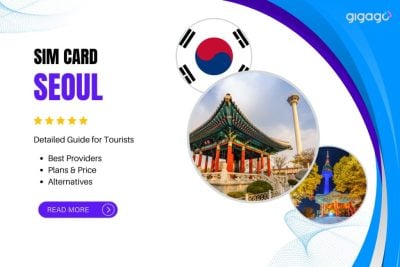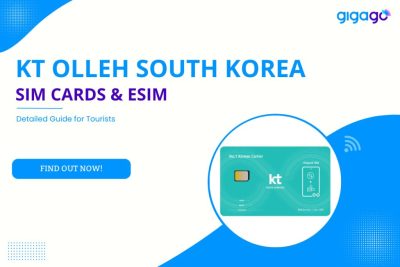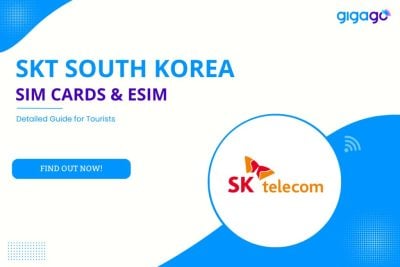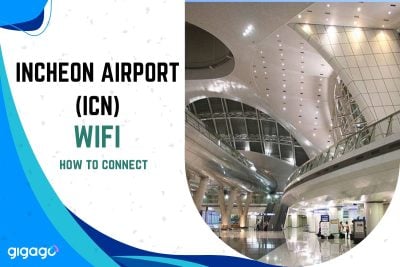From comparing carriers to finding the best deals and exploring eSIM alternatives, we’ve got everything covered to keep you online without the hassle. Let’s dive into the essentials!
South Korea SIM Cards for Tourists: Detailed Guide
When traveling to South Korea or any other country, one crucial decision is how to stay connected. In this article, we will discuss why using a South Korea SIM card is the most suitable choice compared to other options such as relying on free WiFi, roaming with your local carrier, or using pocket WiFi.
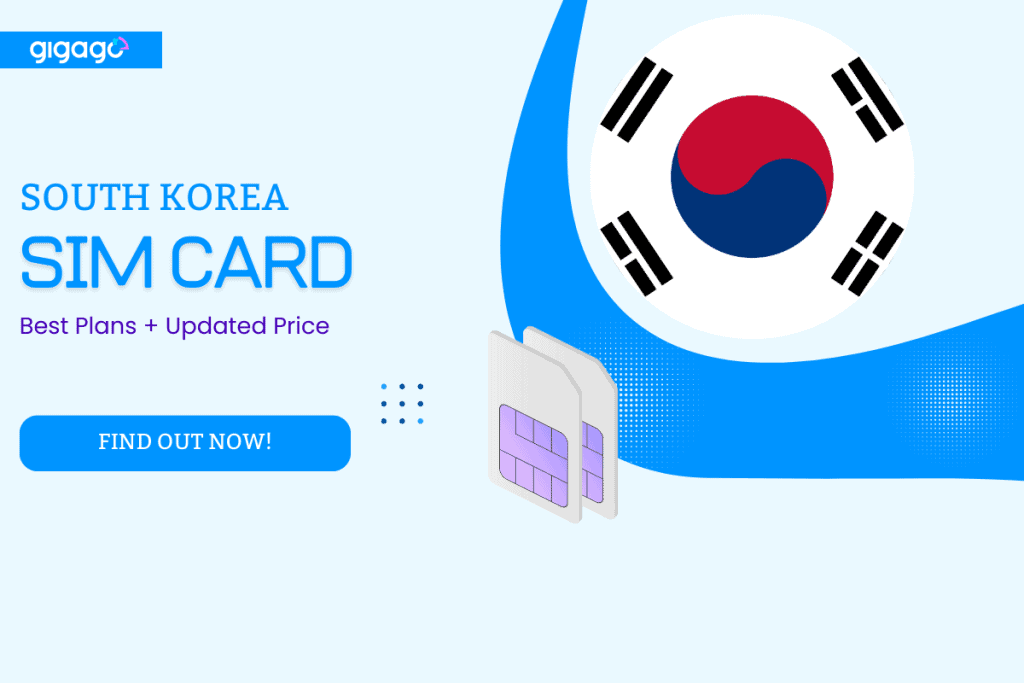
You will gain knowledge about travel SIM cards for South Korea, including the best types for tourists, costs, top network operators, and recommended plans for travelers.
In this article
I. Where to Buy a Tourist SIM Card for South Korea?

If you want to have your SIM card for South Korea, you have 4 ways to get it: buying before departure, buying at South Korea airports, buying in South Korea’s cities and buying South Korea eSIM online.
1. Buy physical South Korea SIM card online, before departure
You can buy a prepaid South Korean SIM card from travel SIM retailers’ websites and have it delivered to your accommodation before your trip or pick it up at the airport after arrival (depending on the SIM provider’s policy).
Pros: Lower prices than airports, be active for trip, have Internet access right upon arrival
Cons: Need to wait for SIM delivery or need to arrange pickup/delivery in South Korea.
2. Buy physical SIM card at South Korea airports
You can purchase prepaid tourist SIM cards like SK Telecom’s Korea SIM Gold/Purple and KT’s Korea SIM Blue Plus at Incheon International Airport, Gimpo airport, Jeju airport, and other major harbors/airports in South Korea.
Pros: have Internet upon arrival, convenient pickup at airport
Cons: require passport, low data, high price and less options than buying in cities.
3. Buy physical prepaid travel SIM in South Korea’s cities
Purchase prepaid SIM cards from carrier stores, convenience stores or electronics shops at major cities in South Korea.
SK Telecom, KT and LG U+ have stores in Seoul, Busan, etc. Most konbini stores also sell SIM cards.
Pros: Cheapest option, can get local advice.
Cons: Need to find stores after arrival in South Korea. Need to show passport and/or personal information when making a purchase. Difficulty in communicating with staff due to difference in language.
4. Buy virtual South Korea eSIM online
You can purchase prepaid eSIM cards for South Korea online from providers like Gigago before your trip. These eSIM cards offer flexible data-only plans without a contract.
Pros: Convenient to set up before travel, no need to look for SIM stores
Cons: Limited availability of eSIM compatible phones
►Our Recommendation:
Here are some advice on choosing where to buy South Korea SIM for tourists:
- If you need immediate connectivity but don’t mind paying a premium or limited options: you can buy at the airport.
- If you prioritize preparation and flexibility: go for buying SIM cards online before departure. Downside is that there will be potentially higher costs for short stays.
- If you seek the best value and don’t mind looking for stores: make a purchase from a store in cities after arrival.
- If you want it all: convenience, preparation, adaptability and cost effectiveness: consider buying an eSIM in advance (of course, you need to have an eSIM-supported device).
To conclude, buying eSIM online seems to be the best way for the average tourist to visit South Korea.
II. What Are The Best SIM Cards for Tourists?
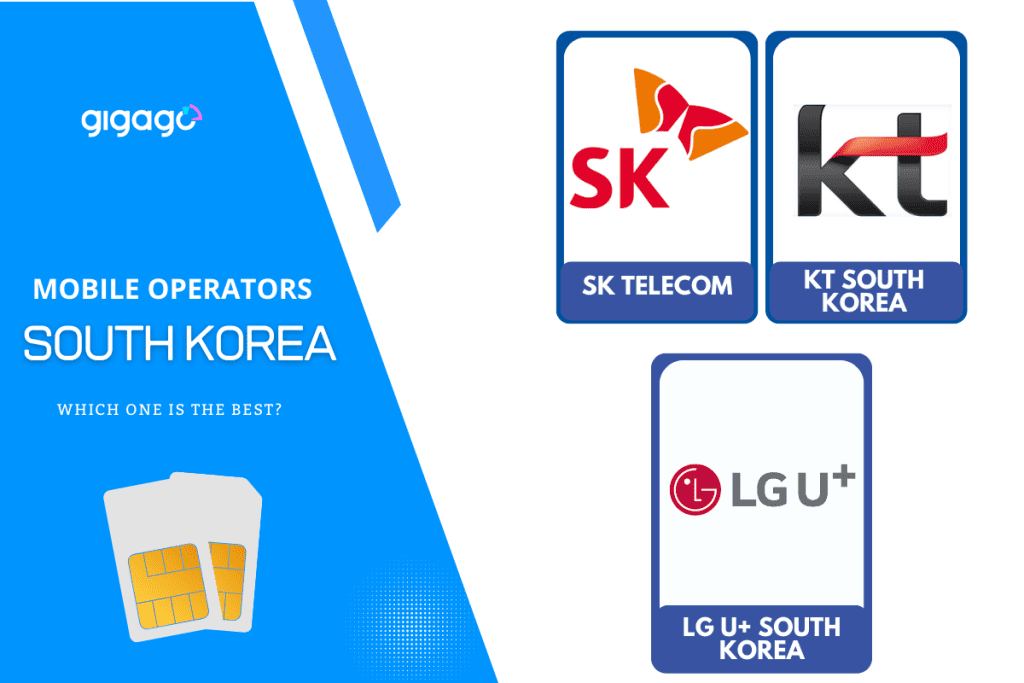
Good to know: For reference:
- 10 KRW = 0.75 USD
- 10 000 KRW = 7.65 US
There are 03 major mobile operators in South Korea: SK Telecom, KT, and LG U+.
These network carriers all offer SIM card plans specially catered towards visitors. Below is a summary of some of their most competitive tourist plans, though specific plan names, prices or features may be subject to change over time.
1. Best South Korea SK Telecom SIM Card Plans and Price
- Unlimited data, 1-day pass = KRW 6,600 ~ $4.59
- Unlimited data, 3-day pass = KRW 18,000 ~ $12.51
2. Best South Korea KT SIM Card Plans and Price
- Unlimited data, 1-day validity = KRW 6,600 ~ $4.59
- Unlimited data, 5-day validity = KRW 24,700 ~ $17.17
- Unlimited data, 10-day validity = KRW 34,600 ~ $24.05
- Unlimited data, 20-day validity = KRW 54,400 ~ $27.82
- Unlimited data, 30-day validity = KRW 64,300 ~ $44.70
3. Best South Korea LG U+ SIM Card Plans and Price
- 120 hours used, 5-day validity = KRW 25,000 ~ $17.38
- 168 hours used, 7-day validity = KRW 32,000 ~ $22.25
- 240 hours used, 10-day validity = KRW 35,000 ~ $24.33
- 360 hours used, 15-day validity = KRW 50,000 ~ $34.76
- 480 hours used, 20-day validity = KRW 55,000 ~ $38.24
- 720 hours used, 30-day validity = KRW 65,000 ~ $45.19
- 960 hours used, 40-day validity = KRW 90,000 ~ $62.57
- 1440 hours used, 60-day validity = KRW 130,000 ~ $90.37
Insights: Here are some insights about plans of each mobile operator in South Korea, which hopefully help you make decisions about which one to choose:
- LG U+ offers plans with data bundled in hours rather than daily limits, which can be suitable for some Visitors.
- SK Telecom has the most affordable short-term plans priced at $4.59 for 1 day and $12.51 for 3 days.
- KT plans are priced competitively but offer fewer validity options compared to SK Telecom.
► Our Recommendation: Overall, SK Telecom provides good value through short-term unlimited plans. LG U+ also presents an alternative with hours-based bundles. Visitors have options based on their preference and duration of stay.
III. Do I Need to Buy a SIM Card for South Korea Travel?
Yes. During your trip, you need Internet to find directions, check transportation schedules, translate signs and menus, make last-minute bookings, and stay in touch with your family and friends back home.
While traveling in South Korea, you may want to see musicals and K-pop shows, and that is when you need a local phone number so as to book tickets. Without a good connection, these tasks become more challenging.
Getting a local SIM card is the most convenient and affordable way to stay connected.
IV. What to Prepare to Buy Prepaid SIM cards in South Korea?
When buying a prepaid SIM card in South Korea, ensure you have your passport for identification and an unlocked phone compatible with local networks. It’s helpful to have local currency (Korean won) for the purchase. Research providers like KT, SK Telecom, and LG U+ to find the best plan that suits your data needs.
V. What Types of South Korea SIM Cards Are Available For Tourists?
Based on the form, there are 02 main types of South Korea SIM cards for tourists.
- South Korea prepaid physical travel SIM card
- Prepaid South Korea travel eSIM.
Each type of SIM card has international and local options. The local SIM card is often used by South Korean citizens while the international one is often used by travelers or foreigners to South Korea.
In this section, what we mention is about the international one. Let’s see types of international SIM card for tourists in details:
1. Prepaid physical SIM card in South Korea
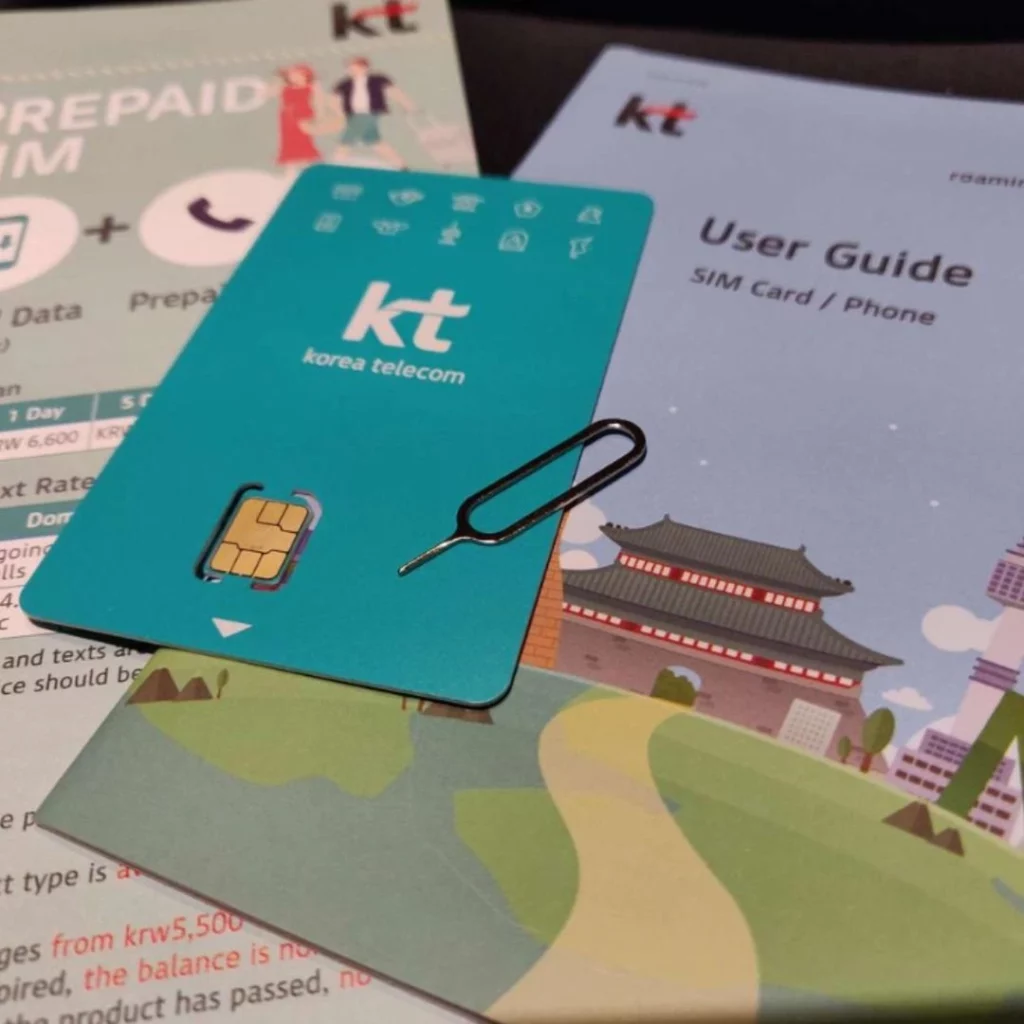
Features:
- Often pre-loaded with set amounts of data, calls & texts
- Easy to purchase at airport shops, convenience stores, electronics retailers
- Ready for immediate activation upon arrival
- Affordable, pay-as-you-go pricing
Plan: 2 types of plan for tourists, which are data only plans and data + voice and text plans
Where to buy: at most South Korean airports like Incheon & Gimpo International Airports; major convenience store chains like CU, GS25, 7-Eleven; or electronic retailers like KT, LG Uplus, SK Telecom.
Suitable for:
- Short-term travelers on vacation or business trips
- Tourists making short visits or transits in South Korea
Requirements: passport to buy offline, unlocked phone
Pros
- Convenient, instant connectivity
- No contracts or credit checks
- Costs can be controlled
- Validity period aligns with trip duration
Cons
- Limited validity period
- Data limits can be restricting for heavy users
- Roaming charges can apply outside South Korea
- Requires purchasing a new SIM card for each visit
- Anyone wanting the convenience of an instant connectivity solution
2. Prepaid Tourist South Korea eSIM
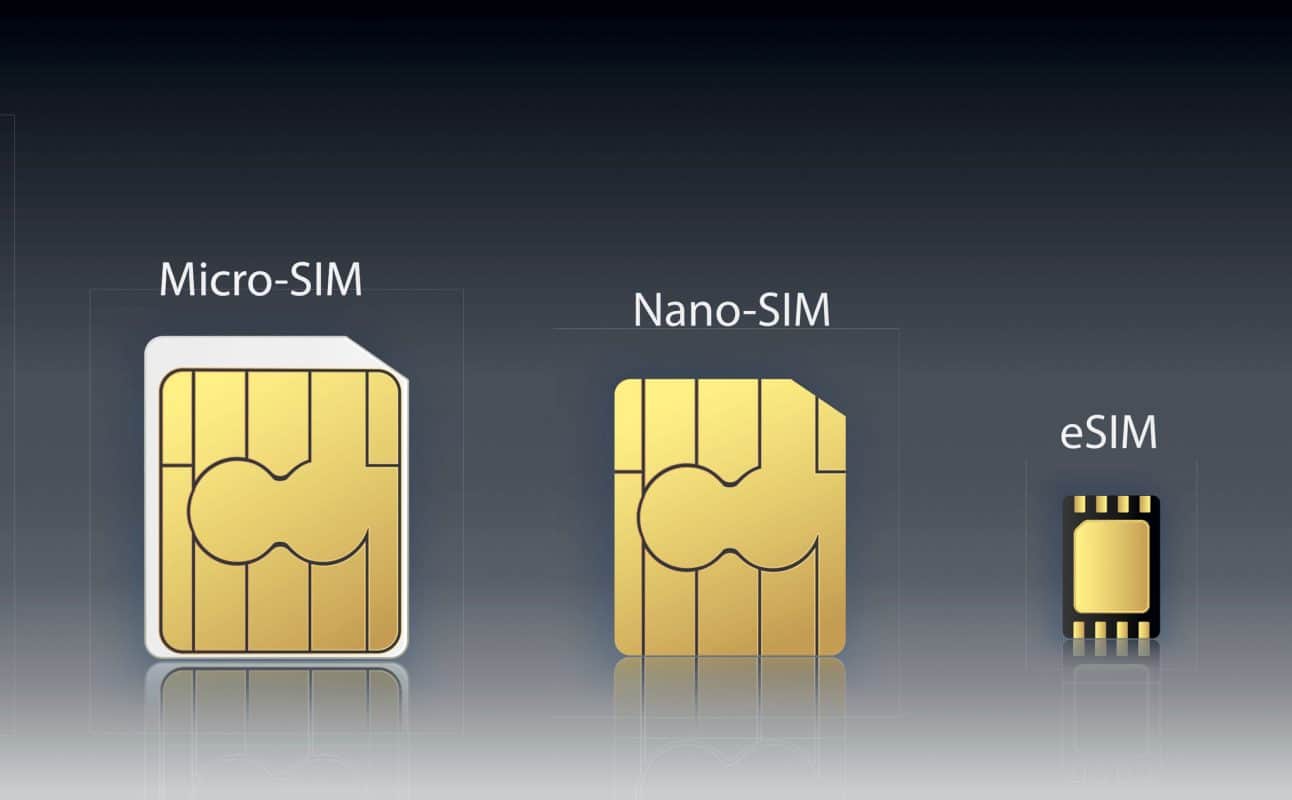
A prepaid eSIM is a digital SIM card stored virtually in a secure data chip inserted in the mainboard of an eSIM-supported device. It does not require a physical SIM card.
Features
- Buy online from anywhere, at anytime
- Use QR code to download the eSIM profile
- One eSIM can store multiple profiles
- Preloaded data allowance and validity period
- Works on eSIM-compatible smartphones
- Remote activation from home country
Plan: 2 types of plan for tourists, which are data only plans and data + voice and text plans
Where to Buy
- Buy online directly from eSIM provider websites
- Buy online from eSIM providers like Gigago
Suitable For
- Frequent South Korea travelers
- Business travelers with recurring trips
- Device limited to one physical SIM card
- Those wanting to activate SIM before arrival
- People with eSIM-compatible phones
Requirements: No need for a passport when buying online, an eSIM-compatible and unlocked phone.
Pros
- No need to purchase physical SIM cards
- Remote activation before arrival
- Avoid SIM card swapping hassles
- Use multiple plans on one device
Cons
- Compatible device with eSIM functionality needed
- More expensive than physical SIM cards
►Our Recommendation:
In fact, a physical SIM card is a regular option to stay connected for many travelers due to its undeniable benefits. However, technology is changing. Now many phones can use a digital SIM card. So, you should:
- Choose a SIM card for your South Korea trip if your phone is not compatible with eSIM and you only want to surf the Internet and stay connected
- Choose INTERNATIONAL PREPAID DATA eSIM for South Korea if your phone supports eSIM, it is highly recommended to use international South Korea travel eSIM due to its convenience, security and flexible plan options.
Note: To use eSIM, your phone needs to be unlocked and eSIM-equipped. Learn how to check if your phone is carrier-unlocked and support eSIM. If you want to quickly check, refer our list of eSIM compatible mobile devices.
VI. Gigago eSIM – Alternative to Physical SIM Cards to Get Internet in South Korea
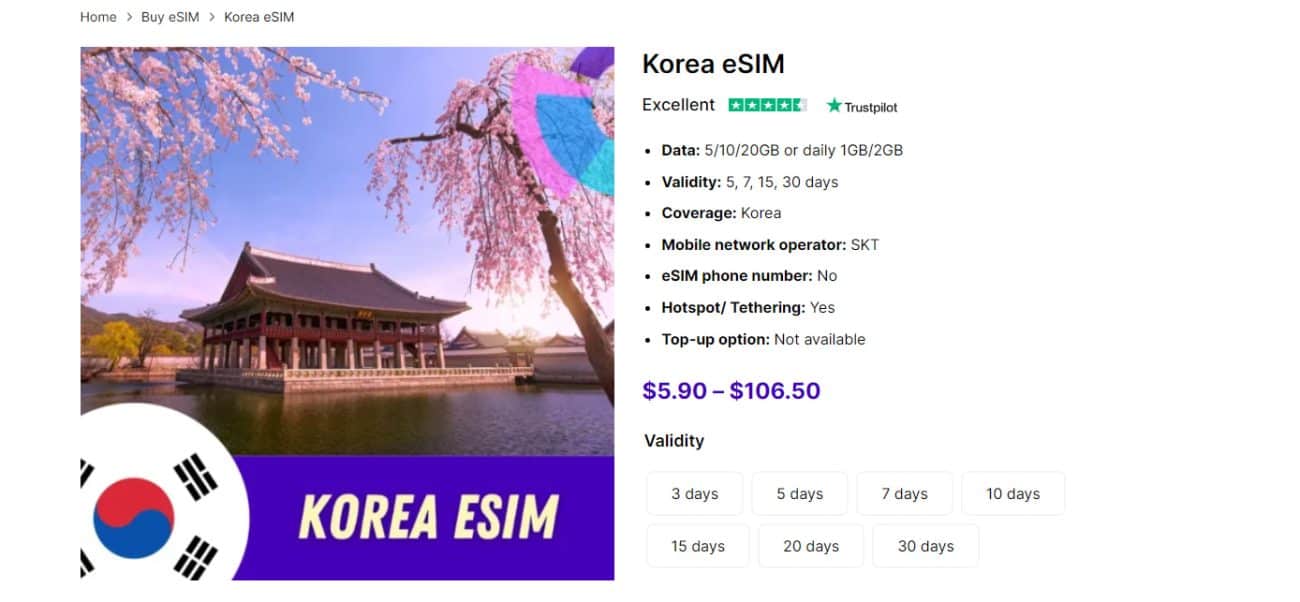
As you can see, South Korea eSIM has many advantages over traditional ones when it comes to staying connected for travelers.
It saves your roaming fees, works like a local SIM, offers reliable coverage, is simple to manage, and has flexible plans that suit different trip length, data needs and budget as well.
When searching for eSIM South Korea providers, GIGAGO is one of the finest eSIM providers that offers reliable coverage in South Korea through the major network SKT. Their eSIM works in all areas of the country so you can stay connected while traveling.
For South Korea, Gigago offers multiple data plan options, starting from 1GB/day for 3 days with $5.90 . What is great about Gigago’s South Korea eSIM is that its plans’ costs are diversifying, vary between $5.90 – $106.50 . Thus, it does not matter how Internet users you are and how long your trip is in South Korea, there is always an option for you with Gigago.
To see more details, visit Gigago South Korea eSIM.
VII. How long does a tourist SIM card last in South Korea?
The duration a tourist SIM card lasts in South Korea typically depends on the provider and the specific plan you choose. A prepaid SIM card typically remains active for 30-60 days after the last recharge. Therefore, it can stay valid for up to 6 months with continuous recharging. You can top up your prepaid SIM online, at convenience stores, or via ATMs (if you have a Korean bank account).
VIII. How to Use South Korea Prepaid SIM Cards and eSIM
1. Using prepaid South Korea tourist SIM Cards
Here are the main steps to use a South Korea prepaid SIM card:
- Purchase a prepaid SIM card from major carriers like KT, SK Telecom or LG Uplus before or upon arrival. Cards are at convenience stores.
- Follow instructions to activate the card. Insert SIM into phone and power on.
- The SIM will have a temporary phone number. Note or screenshot this number for next steps.
- Top up the balance with cash at stores like 7-Eleven or CU. Give them the phone number and amount.
- Use the SIM for calls, texts and data in South Korea. Most include a starting amount.
- Download the provider’s app to check balances, top up credit and manage the account easily.
Pro Tip: Some tips on using prepaid tourist SIM card during your trip in South Korea:
- Carry some cash for top ups.
- Download maps before trips with no data.
- Use WiFi when possible to avoid data costs.
- Set up data limit alerts to control usage.
- A prepaid SIM ensures affordable connectivity.
2. Setting up and activating South Korea eSIM
To use a South Korea eSIM for your upcoming trip, follow these steps:
- Buy an eSIM online from a prestigious eSIM provider (like Gigago) before departure or upon arrival at the airport.
- Scan a QR code or enter activation details to activate eSIM online
- Once activated, the eSIM will be downloaded directly to your device. Make sure your phone is eSIM compatible.
- You can now use the eSIM for data (and calls, texts) within South Korea just like a regular SIM.
Pro Tip: Depending on the plan’s policy about activation time, oftentimes, you are recommended to activate the eSIM one day before departure to save validity period.
IX. FAQs about South Korea SIM Cards
How much is data SIM in South Korea?
They offer monthly data SIM plans starting from 15,000 KRW (around 12 USD) for 2GB data.
SK Telecom: Their prepaid data SIM plans begin at 15,000 KRW for 1.5GB data valid for 30 days.
LG Up+: This network provides a 1GB prepaid data SIM for 10,000 KRW that lasts 7 days
Why is mobile data so expensive in South Korea?
The lack of strong competition, investment in cutting-edge networks, high demand and subsidies add up to make mobile data somewhat pricey in South Korea compared to other developed markets.
Can I buy a SIM card in convenience stores in Korea?
Yes, you can easily buy SIM cards in convenience stores in South Korea like 7-Eleven, CU, GS25 and Emart24. They’re located all over cities and highways. Purchasing a SIM is simple – pick your provider and data plan amount, pay at the counter and the clerk will activate it for you.
XI. Conclusion
To conclude, using a prepaid South Korea travel SIM card is undeniably convenient for staying connected during your trip in South Korea rather than relying on international roaming with your regular plan. However, if your mobile device has eSIM function, going for a prepaid eSIM package would be more convenient. Using an eSIM, there is no need to worry about carrying around physical SIM cards. This makes an eSIM the best option for staying seamlessly connected while traveling in South Korea.
